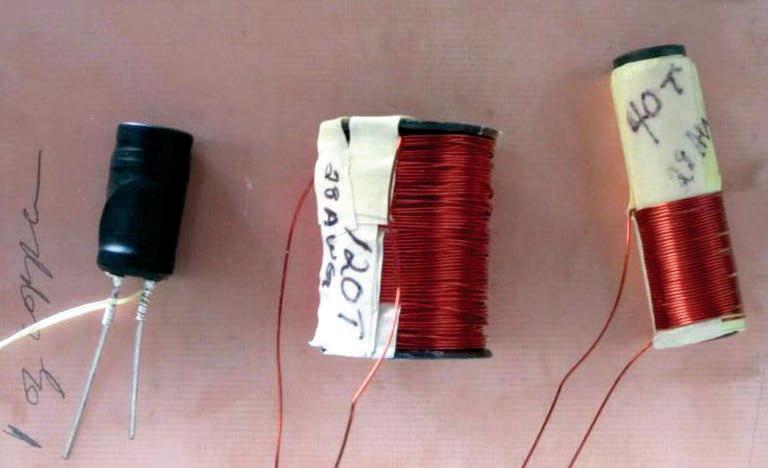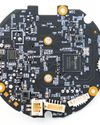
Eddy currents are swirling electrical currents created when a magnetic field is moved over a conducting metal, or the metal is moved through a magnetic field. George writes about his experiments using eddy currents to determine the layer thickness of copper on PCBs and aluminum and copper foils. He also describes a simple eddy current apparatus that he built using a PC, a single resistor, and a USB sound card to measure thickness.
Eddy currents are generated in a metallic object when a magnetizing coil with alternating current in its windings is brought close to the object. These remarkable eddy currents are one of the most extensively utilized electromagnetic concepts with applications including thickness measurement of metal plates or insulating coatings, detection of surface flaws or discontinuities, conductivity testing, and identification of metal alloys.
These methods provide low-cost, high-speed testing of metallic materials, without requiring direct coupling.
Over the years, many different techniques and devices have been used in these various applications. In this study I will focus on the ideas related to finding the thickness of a thin metal sheet or plate. Research has shown that there may be a direct way to achieve this goal. These efforts have led to the method employed here, which uses experimental data to determine how the terminal impedance of an eddy current (EC) sensor is related to a physical property of the material-in this case, the thickness of thin films. Here I focus on copper layer thickness on printed circuit boards (PCBs) and aluminum foil.
EC sensors can be very simple or complex depending on the job to be done.
For this project, single coil EC sensors were constructed. It was also found that lowcost, off-the-shelf devices could be easily repurposed for use as sensors.
هذه القصة مأخوذة من طبعة December 2024 من Circuit Cellar.
ابدأ النسخة التجريبية المجانية من Magzter GOLD لمدة 7 أيام للوصول إلى آلاف القصص المتميزة المنسقة وأكثر من 9,000 مجلة وصحيفة.
بالفعل مشترك ? تسجيل الدخول
هذه القصة مأخوذة من طبعة December 2024 من Circuit Cellar.
ابدأ النسخة التجريبية المجانية من Magzter GOLD لمدة 7 أيام للوصول إلى آلاف القصص المتميزة المنسقة وأكثر من 9,000 مجلة وصحيفة.
بالفعل مشترك? تسجيل الدخول

New TI MCUs Enable Edge AI and Industry-Leading Real-Time Control to Advance Efficiency, Safety, and Sustainability
Texas Instruments (TI) introduced two new series of real-time microcontrollers that deliver advancements to help engineers achieve more intelligent and secure processing in automotive and industrial applications.

Using Amazon Alexa to Control Custom IoT Gadgets
In part two of his article, Brian describes integrating custom IoT gadgets with Amazon Echo using emulation to receive spoken alarms. In part one, he used emulation and Arduino Cloud services as a middleman.

Holiday Hangover Hardware Hacking
Having too much cheer during the holidays? In this month's article, Colin offers a diversion from the jolly season by urging developers to retreat to the basement to brush up on hardware hacking skills. He shows how a low-cost Raspberry Pi Pico and a TP-Link Tapo C200 smart IP camera could become the next automated bird deterrent or a home automation server.

Datasheet: Microamps Per Megahertz Ultra-Low Power MCUs Minimize Current Consumption
How do chip makers differentiate if many ultra-low power MCUs on the market feature the same processor core? The peripherals and different power states offer various ways to manage current consumption down to microamps per megahertz.

Smart Home Lock Down Matter Provides Security Blanket
As more devices in the smart home connect to the Internet, they become increasingly vulnerable to outside attacks. Developers can now add the latest security measures to their Smart Home devices through Matter.

Basic Pulse Circuits
In part one of a three-part series, Wolfgang wrote how basic pulse circuits help digital circuits, such as embedded boards with ARM processors, deal with pulse trains or bursts of pulses from the outside. In Part 2, he dives into enabling flip-flops, timing parameters, and synchronization, design tasks needed to capture, detect, and filter pulses.

Building a Wi-Fi Router Watchdog
Dev created a watchdog for a Wi-Fi extender using a Raspberry Pi Pico. This monitors Wi-Fi connectivity for his smart home lighting system, which would require a reset twice a year due to rapid power interruptions.

Create Your Own PCBs with a CNC Milling Machine
Using KiCad, CopperCAM, and Candle Software

Performance Bottlenecks in Embedded Linux Solutions Analysis, Identification, and Mitigation
Good performance is a requirement for every technology, and system designers rely on operating systems to ensure fast and smooth transitions in critical applications. Fortunately, Pedro writes, the embedded Linux OS offers ways for finding, analyzing and mitigating performance bottlenecks so embedded systems can deliver the speed and efficiency that end users expect.

Renesas New RA8 Entry-Line MCU Groups Brings High Performance of Arm Cortex-M85 Processor to Cost-Sensitive Applications with Market-Leading CoreMark Performance
Renesas Electronics Corp., a premier supplier of advanced semiconductor solutions, introduced the RA8E1 and RA8E2 microcontroller (MCU) groups, extending the industry's most powerful series of MCUs.